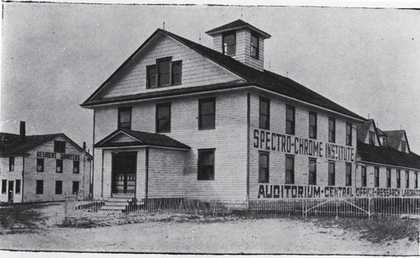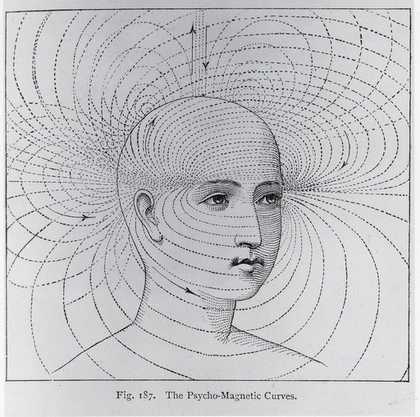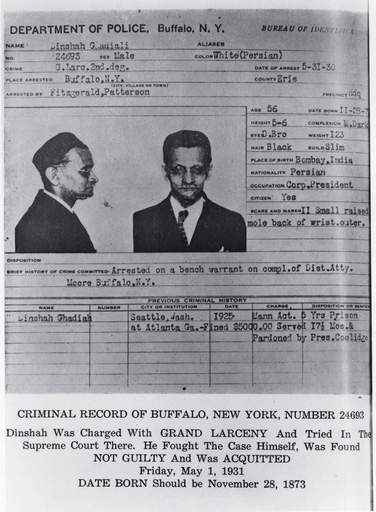In 1920 Colonel Dinshah P. Ghadiali invented the Spectro-Chrome. It was a simple aluminium colour projector, but its creator claimed it had a miraculous power. Ghadiali, who described himself as a metaphysician and psychologist, believed that by focusing a specific colour on a particular part of the body at an exact time of day – which he catalogued in a series of regional astrological timetables – you could cure almost any malady. “The Spectro-Chrome is NOT a lamp,” he wrote of his device, which was equipped with a 1,000 watt bulb, a water cooler and five glass slides that could be combined to make a total of twelve colours, “it is a system, a new, original and unique science.”
His three-volume instruction manual, The Spectro-Chrome Metry Encyclopaedia, was crammed full of case histories documenting the miraculous successes he attributed to “attuned colour waves” – a paralysed woman was able to walk again after intensive treatment, a badly burned infant now had satin-white silky skin and a blind man’s sight had been restored. He hoped that one day, as his slogan put it, there would be a “Spectro-Chrome in Every Home” in America, where he emigrated from India in 1911. He founded the Spectro-Chrome Institute to train up “normalators”, as he called his salesmen and graduates, to restore people’s “radio-active and radio-emanative equilibrium” with colour. He sold 10,000 machines (the most expensive of which cost $750) before the Food and Drug Administration (FDA) started investigating him for quackery. “Substantially in excess of one million dollars,” the FDA’s report claimed, “has been extracted from the pockets of the public by Spectro-Chrome.”

The Spectro-Chrome Institute, Malage, New Jersey 1933
© Courtesy of the National Library of Medicine
Ghadiali’s story reads like an eccentric footnote in the history of medicine, but at the time he was not alone. Scientists and psychologists had first started experimenting with colour therapy in the 1880s; by 1938 you could buy the Emesay, Kromayer, Alpine Sun, Helion and Chromoclast lamps, all kitted out with localising masks and colour filters for chromo-therapy. The Spectro-Chrome was the best known of these devices. Contemporary manuals display pictures of patients lying down to receive “tonations” under blue or red light, stripped to the waist, wearing goggles, or having their gums, dental sockets and ears irradiated.
As John Gage shows in his definitive history Colour and Culture (1995), the way we see colour is associative rather than empiric – for example, we think of blue as cool, expansive and soothing, even though the blue bit of a gas flame is hotter than the orange. Colour has different meanings in different contexts, but, Gage writes, “there seems to be a universal urge to attribute affective characters to colours”. Practitioners of chromo-therapy were convinced that colour was primarily a question of immediate feeling rather than intellectual judgment, and that it could have profound psychological and physiological influences. This belief in the powerful corporeal effects of colour influenced avant-garde artists such as Gaugin and Kandinsky, who thought of chromo-therapy as a useful tool in developing a non-representational art, because it provided the grammar for a supposed universal language of colour. But though chromo-therapy was once an intellectual fashion, its role in the story of modern art is largely forgotten. Where did the idea that colour could heal come from?
In the West, theories of colour evolved out of alchemy and medicine; colour was, therefore, intimately bound up with the therapeutic. The first colour circles were urine charts used by physicians to identify an imbalance of the four humours. A fifteenth-century example, from an anonymous Treatise on Urine, shows a radial pattern of twenty vials in various hues, running from clear (indicative of a phlegmatic temperament) to black (melancholic) through a series of yellow ochres (choleric) and blood reds (sanguine). Potions and herbs were often chosen by doctors on the basis that their colour opposed and would therefore harmonise any humoural lopsidedness.
In his influential Theory of Colours (1810), Goethe developed this relationship between colour and Hippocratic medicine. He and his friend, the Romantic philosopher Friedrich Schiller, also visualised colour relationships in a circle – which they called a “Temperamental Rose” – but they adapted the entire spectrum (not just those shades relevant to the medical diagnosis of bodily fluids) to the four humours. Green and yellow represented the active, sanguine character, exemplified by bon vivants, lovers and poets. Purple and blue-red characterised the passive and melancholic type – monarchs, scholars and philosophers. However, for Goethe, colours weren’t just arbitrary symbols of these bodily states, they could also produce them. “Every colour,” he believed, “produces a corresponding influence on the mind.”

The Psycho-Magnetic Curves from Edwin Babbit’s Principles of Light and Color, I
© Courtesy of the National Library of Medicine, Washington
Goethe tried to prove that colour had a direct, rather than mediated, effect on our feelings by tinting his laboratory windows alternately yellow, red, green and blue. He concluded that “the eye could be in some degree pathologically affected by being long confined to a single colour; that, again, definite moral impressions were thus produced… sometimes lively and aspiring [yellow], sometimes soft and yearning [blue], sometimes uplifted to the noble [red], sometimes dragged down to the base [green]”.
His own house was decorated according to this scheme. Unpopular guests never made it past the “Juno room”, which was painted a “gloomy and melancholy” blue so that they wouldn’t be tempted to stay long. The lucky ones who had dinner invitations were led into the warmth of his yellow dining room: “The eye is gladdened,” he hoped, “the heart expanded and cheered, a glow seems at once to breathe towards us.” He preferred to work in a green garden room as he found the neutral admixture of yellow and blue to be peaceful and soothing.
Following Goethe, doctors began using colour not just as an aid to diagnosis, but as a cure in itself. The French psychologist Charles Féré, who worked under Charcot at the famous Salpêtrière Hospital in Paris, was convinced of its psychological therapeutic properties. He began experimenting with coloured light on hysterics in the 1880s, glazing asylum cells with blue or violet glass to create calming and curative effects. Féré thought of coloured light as different waves or vibrations of radiant energy that could be sensed not just by the eyes, but all over the skin in a form of cutaneous vision. In 1887 he set up a device, invented by Etienne-Jules Marey, who pioneered the photography of serial motion, to test this peculiar theory. It was a primitive oscillograph which measured the contractions of the hand and forearm under the influence of various coloured lights, definitively proving, Féré thought, that red had the most exciting effect and violet the most calming.
Other doctors had already followed Goethe’s lead. Dr Ponza, Féré wrote excitedly, “has announced happy effects from red light in melancholics and blue light in maniacs”, and Dr Davies, of the County Lunatic Asylum in Kent, “has obtained four cures of maniacs by the same treatment, but has not obtained any results in melancholics”. (However, Féré admitted, “the experiments of M Taguet had a negative result in all cases”.) Colour treatment soon became fashionable. The illustrations in Seth Pancoast’s Blue and Red Light: or, Light and its Rays as Medicine (1877) show a well-dressed woman sprawled languidly on a couch as she bathes in coloured light. One contemporary writer dubbed the resulting craze the “blue glass mania” and offered the following prescription: “Blue glass one part; faith, ten parts; mix thoroughly and stir well until all the common sense evaporates, as the presence of a minute quantity will spoil the mixture.”
However, apparently lacking in common sense, the research conducted by scientists and physicians into the psychological power of colour inevitably influenced artists, who found in this work an affirmation of the moral significance and physiologic impact of their medium. Paul Gauguin’s use of bold, flat planes of non-representational colour, as seen in Faa Iheihe 1898, was directly inspired by chromo-therapy. “Since colour,” he wrote in his diary, “is in itself enigmatic in the sensations which it gives us (note: medical experiments made to cure madness by means of colours) we cannot logically employ it except enigmatically… to give musical sensations which spring from it, from its peculiar nature, from its inner power, its mystery, its enigma.”
Kandinsky, who had been impressed by Gauguin’s forceful use of brilliant colour when he saw his paintings in Paris in 1902, came across chomo-therapy when he read Arthur Osborne Eaves’s The Power of Colours (1906). “Colour directly influences the soul,” Kandinsky wrote in Concerning the Spiritual in Art (1912). “Anyone who has heard of colour therapy knows that coloured light can have a particular effect upon the entire body. Various attempts to exploit this power of colour and apply it to nervous disorders have again noted that red light has an enlivening and stimulating effect upon the heart, while blue, on the other hand, can lead to temporary paralysis.”
Kandinsky was a synaesthete (“Sometimes I could hear the hiss of colours as they mingled,” he wrote), and in his abstract paintings he blurred modern science’s belief in the psychological effects wrought by colour with the theosophists’ conviction that coloured auras, to which most people are blind, surround all persons and things. The theosophist Annie Besant published a colour chart in 1901, along with examples of abstract “thought-forms” reminiscent of some of Kandinsky’s paintings, so that those who could see auras would hold a key to their emotive meanings. In his “colour study” paintings, such as Squares with Concentric Rings 1913, Kandinsky intended to create musical and bodily effects with colour combinations, thereby hoping to “prove that colour contains within itself a little studied but enormous power, which can influence the entire body as a physical organism”.
It was the occult, primal, physiological power attributed to colour that Dinshah Ghadiali sought to harness with the Spectro-Chrome. He had first become interested in the therapeutic properties of colour when he was initiated into the Theosophical Society, which he joined in 1891 as a young man. In the library at the theosophists’ headquarters in Bombay, he read and was entranced by Edwin Babbitt’s The Principles of Light and Color (1878). Babbitt, an American teacher, believed that everyone radiated their own brightly coloured energy, and that sick-ness was caused by an upset in the natural harmony of this colour field. He invented the Chromolume, a stained glass window composed of sixteen colours, which he sold for $10 and claimed could help to restore this natural balance. When Ghadiali emigrated to America in 1911, he began to elaborate on Babbitt’s theories, mixing them with Hindu and Parsee philosophy and his own brand of showmanship, and updating the Chromolume to the era of electric light.
However, the FDA’s investigation into Ghadiali’s device, and the resulting court case that began in October 1946, put the ancient theory of colour on which it was based on trial. The FDA found that most of Ghadiali’s qualifications – he referred to himself as “Colonel Dinshah P. Ghadiali, MSC, MD, ME, DC, PhD, LLD, ND, Dopt, DFS, DHT, DMT, DST” – were bogus; his MD, for example, was bought for $133.33 from Oskaloose College, a diploma mill in Iowa. He’d served eighteen months in prison in 1925 for having sex with an underage girl, and in 1931 was arrested for second degree grand larceny in Buffalo when someone who had purchased a Spectro-Chrome claimed he’d been cheated into buying it. He was acquitted that time, having got a surgeon from the Women’s Hospital in Philadelphia to swear by the device. On this occasion the government called 76 witnesses, including several of its own experts who had conducted independent clinical trials with the Spectro-Chrome. They found the machine, and chromo-therapy in general, to be “ineffective and worthless”. The use of coloured lights would have no effect on health, the FDA asserted, “and when used as directed, or in any manner whatsoever, may delay appropriate treatment of serious diseases, resulting in serious or permanent injury or death to the user”. It attacked five of the case histories in The Spectro-Chrome Metry Encyclopaedia, proving that his claims to have cured these patients were false. The paralytic, photographed in the book to demonstrate she was able to walk after her therapy, was pushed to the witness stand in a wheelchair. She explained that she had been held upright until the camera was focused, wobbled for a fraction of a second while a picture was snapped, and was caught as she tumbled to the floor.
Any cures that had been made were attributed to auto-suggestion, or to the diseases and fevers having run their natural course. Ghadiali called 173 witnesses in his defence (the trial lasted two months as a result), but his case effectively crumbled when one patient of Spectro-Chrome Metry, who had supposedly been cured of epilepsy through “tonations” of Orange Systemic, went into seizures on the stand, slumped to the floor, vomited and swallowed his tongue. A professional doctor rushed over to him and stopped him from choking to death. “The Jury was sent out and the court was recessed,” read the FDA’s notes on the trial. “Dinshah P Ghadiali stood coldly by and neglected to offer Spectro-Chrome treatment.” Ghadiali’s dream of having a “Spectro-Chrome in Every Home” ended when he was thrown in prison for three years, fined $20,000, and further production of the device was outlawed.

Dinshah Ghadiali’s criminal record, 1931
© Courtesy Medical History and Art
That same year, the Swiss psychologist Dr Max Lüscher developed a colour test which consisted of a person sorting 73 colour patches into an order of preference (an abbreviated test of eight cards was also used), and claimed to be able to judge personality from the results. He even believed that “it is sometimes possible to deduce personality characteristics of a painter when great emphasis is placed on one or two colours, for example, Gauguin’s obsession with yellow in his later paintings”. His ideas served to boost interest in chromo-therapy, reviving a fashion just as the FDA was recalling all of Ghadiali’s devices. Lüscher was influenced by both Goethe’s theory of colour and Kandinsky’s neo-Romanticism – and thought his test worked as “an early warning system for stress ailments… cardiac malfunction, cerebral attack or disorders of the gastro-intestinal tract”. He was convinced colour had fixed primal associations that took us back to an ancient fear of the dark, to hunting and self-preservation. “The test is a ‘deep’ psychological test,” Lüscher asserted, insisting on its scientific veracity, “developed for the use of psychiatrists, psychologists, physicians… It is NOT a parlour game.”
His theories were taken up not only by psychiatrists and therapists, but by the advertising and marketing industries, where they had a wider and more long lasting influence. For example, Lüscher advised that sugar shouldn’t be sold in a green package, as the colour is associated with astringence, whereas blue was associative of sweetness. In the 1960s, the American scientist Alexander Schauss read Lüscher’s musings on colour psychology, packaging and décor and began his own research into the physiological effects of colour. He thought he’d discovered a colour with a profoundly calming effect and was keen to put it to use. Beginning in 1979, he persuaded a number of American prisons to paint their cells a camp, but supposedly pacifying shade. If only he’d done so in time for Ghadiali’s confinement, the Bombay colour theorist might have found himself in a cell painted a bright Indian pink.

